Shock Exchange
Guitar World 11/97 p53-55, 112-124Jane’s Addiction is back – if only temporarily – and they got Flea with ‘em. Guitarist Dave Navarro and the righteous bass man rap about the good old days and their bold old ways.
by Alan di Perna
photography by John EderDave Navarro and Flea are sitting together on the famous “sideways” rocking chair form the cover of Jane’s Addiction’s 1988 album, Nothing’s Shocking. They’re huddled together like two schoolboys on a bus, giggling, exchanging whispered jokes., setting up a force field of friendship to insulate them form the prying eye of the photographer’s lens. the glaring floodlights and the coldly appraising gazes of assorted makeup artists, dressers, and assistants. Navarro hates photo shoots. But Flea seems to welcome an opportunity to dress up like his newest heroes, Sixties black power militants the Black Panthers. He’s even brought along a Panther uniform (black leather jacket, black turtleneck, black beret, wraparound shades) for Dave.
When the world first saw the “sideways” rocking chair, it was, of course, holding a sculpture of Siamese twins, naked, female, created by Jane’s Addiction leader Perry Farrell who set the figures’ heads alight for the controversial Nothing’s Shocking cover photo. Prepare to be shocked once more, because Farrell has now reconvened Jane’s Addiction. The return of the band that instigated the alternative rock Nineties will be marked by a CD containing one brand new song and a slew of previously unreleased material, demos and live recordings from the first incarnation of Jane’s Addiction.
Although the final track listing was still being settled at press time, rarities likely to appear on the disc include the original 1986 demo for “Mountain Song,” an ‘88 demo of “Ocean Size” and alternate studio takes of Jane’s hits like “Been Caught Stealing,” from Ritual de lo Habitual, and “Had a Dad” from Nothing’s Shocking. Among the never-heard-before songs tentatively scheduled for inclusion are a demo called “Macio” (the name of Perry Farrell’s cat) and “Slow Divers,” the opening song from the 1987 show that was recorded to create the self-titled live debut from Jane’s Addiction on Triple-X records. A 1986 live recording of “Whores” captures the sound of a very early Jane’s Addiction, shortly after they got together, while live renditions of “Three Days,” “Stop,” “Up the Beach” and “Ain’t No Right,” document Jane’s Addiction at the height of their roaring, glorious power, onstange at the Hollywood Palladium in 1990.
Along with all this aural history, there’ll be a brand new studio track, “Kettle Whistle,” recorded by the revamped, 1997 Jane’s lineup: Perry Farrell, Dave Navarro, drummer Stephen Perkins and… Flea! When original Jane’s bassist Eric Avery declined to participate (preferring to focus on his current band, Polar Bear), Flea was named his successor. The Red Hot Chili Pepper’s resident bass animal will also hit the road with the “relapsed” Jane’s Addiction, as Farrell is calling it. Since all four original members aren’t involved, he figures it can’t properly be described as a reunion.
Whatever you want to call it, Flea was a natural choice. He and Navarro have build up a solid partnership over the four years they’ve been playing together in the Red Hot Chili Peppers. To spend time with them is to be in the presence of two human beings who clearly enjoy each other’s company – something which can’t be said of too many people who play in a band together.
On a purely musical level, Flea and Navarro are just as well-matched. Both are innovators and restless perfectionists. Flea’s sizzling syncopations with the Red Hot Chili Peppers have established him as the foremost funk rock bassist in the universe. Navarro’s fiery fretwork with Jane’s Addiction pioneered the use of metal-influenced guitar in a post punk context, which is one of the major reasons Jane’s Addiction occupy such an important place in the formative history of the alternative Nineties.
When the original Jane’s Addiction split up in 1991, Navarro ditched his own heroin addiction and joined forces with the Chili Peppers, who’d gone drug free themselves. Navarro and Flea hit a strong grove together in the Pepper’s 1995 album, One Hot Minute. Beyond that, they became a formidable L.A. session team, guesting on records by everyone from Alanis Morisette to, well, Porno For Pyros, Perry Farrell’s post-Jane’s band. Dave and Flea played on “Freeway,” a track from the second Porno album, Good God’s Urge and on “Hard Charger,” a song Porno for Pyros contributed to the soundtrack of Howard Stern’s movie, Private Parts. Jane’s/Porno drummer Stephen Perkins had earlier played percussion on “One Big Mob.” from the Chili Peppers’ One Hot Minute.
In other words, the Peppers and the Jane’s/Porno camp have become one big, happy incestuous family over the past few years – an extended clan of free spirits, a tattooed tribe of pierced L.A. pagans. Which is how Flea and Navarro now come to be posing in the Nothing’s Shocking chair, in the garage of Perry Farrell’s house. The edifice in question is a flat rate piece of modern architecture lodged in a somewhat dowdy middle class L.A. neighborhood. Much like its owner, the house definitely stands out from its surroundings. Mr. Farrell is off on a surfing expedition in Indonesia, but he’s graciously made his home available to Guitar World for the photo shoot and interview with Flea and Dave Navarro. Once the pictures are completed, the duo slip into something more comfortable – their bare skin, for the most part – and gather around Farrell’s Japanese-style dining room table to discuss their ongoing friendship, musical partnership and the return of Jane’s Addiction. But before we begin, Flea has something he want to get off his copiously tattooed chest.
Flea: I just want to say “fuck you” in advance to all the people who are going to write bad letters after we’re on the cover and they read this article. Every time I do one of these things, there’s all these letters saying, “He doesn’t know anything about music and he’s so technically incompetent, and I don’t want to hear about intuition, feeling and spirituality. ‘Cause it’s all bullshit. Learn how to play.” I get these letters every time.
Dave Navarro: Really!?
Flea: So I just want to say in advance: Fuck you already. I’m on the cover and you’re not. Fuck you.
Navarro: We should also say that we are in no way poking fun at the Black Panthers in the photos. We are saluting them.
Guitar World: What is this fascination with the Black Panthers?
Flea: I saw a documentary the other night on television that was basically about the [San Francisco] Bay Area counterculture in the Sixties. And part of it was on the political activism of the Black Panthers. I was just looking at all the hippies wearing their hippie clothes and flowers and beads, and bongo drums and beards and all that shit. Then they show the Black Panthers and they’re just the coolest looking guys you ever saw. And I’m all for them. To tell the truth, Soul On Ice, by [onetime Panther] Eldridge Cleaver, changed my life. So for the Black Panthers I have nothing but respect.
GW: Who actually proposed this “relapse” of Jane’s Addiction? Who made the first call?
Flea: It was called by Perry. He asked me to play. I said, “Hold on, let me check my schedule.” I came back about two milliseconds later and said okay.
Navarro: I can’t remember any actual call saying, “We’re gonna do this.” The idea just kind of evolved. Perry and I kept in touch over the years. The idea was brought up about a year ago, actually, but nothing ever came of it them. I never really count on anything until it actually happens, because I don’t like to set myself up for disappointments. Actually, I remember getting a message from Perry saying he wanted to talk to me about a project. I didn’t talk to him for about three weeks afterwards. Then I ran into a mutual friend who said, “Oh yeah, I think Perry wants to do a Jane’s Addiction reunion.” And I was like, “woo hooooo!”
GW: With the two of you playing with Porno for Pyros on “Freeway” [from the album God’s Good Urge] and on “Hard Charger” for the Private Parts soundtrack, I suppose it was becoming increasingly inevitable that something like this was going to happen.
Flea: Yeah. Although “Freeway” was much more a Porno for Pyros thing that Dave and I just came in and guested on. Whereas with “Hard Charger,” it was still Porno for Pyros, but I just felt like it was more of a new thing. We were involved more in the creative process. It was more of a new band type of feeling.
Navarro: We got together and rehearsed for that and arranged it and recorded it, and did shows. We did Howard Stern, did a New York show. So yeah, that was more of an evolution towards this than “Freeway.”
GW: Are either of you Howard Stern fans?
Flea: I don’t listen to talk radio. I don’t take part in that ritual.
Navarro: I’m a total 100 percent fan. If I’m ever up that early, I listen to it.
Flea: If I listened, I might be a fan. I just don’t know enough about it.
GW: Was he fairly cool?
Navarro: Howard? I never actually met the man.
Flea: We played at the premiere of his movie. And we were standing in that aisle where you walk down and do press – where all the guys line up. And I was walking along and Howard came up with his circle of bodyguards around him. One of them pushed me and said, “Hey, get away, buddy.” And I grabbed him by the shoulder and said, “Hey, don’t you fucking touch me, motherfucker.” All my Zen Buddhist concepts went out the window and I was going to punch the guy out. But that wasn’t Howard. It was some strange bearded man.
Navarro: My first memory, and it’s hardly what I’d call a memory, was when Flea came to play trumpet on our record. [“Idiots Rule,” on Jane’s Addiction’s Nothing’s Shocking]
Flea: But you weren’t there when I played trumpet!
Navarro: Yes I was. I remember Perry telling you what to play [sings riff]. That’s what was great about Perry. We had this song, “Idiots Rule,” that Flea and Angelo Moore and Chris Downd from [pioneering L.A. ska/rock/funk band] Fishbone came down to play on. And they had this horn section part worked out that took a Jane’s Addiction song and, somehow, within on pass of tape, turned it into a Fishbone song. So Perry trimmed away some of the fat and it became what it is now. But that’s my first memory of Flea. Although I have other weird, clouded memories of Flea back in those days. I have an Anti Club memory [The Anti Club is a small L.A. venue where underground acts play. – GW ed.]
Flea: Was I drinking beer?
Navarro: All I remember is you had a 7-11 shirt – like the ones the guys who work in 7-11 are supposed to wear.
Flea: I loved that shirt! I was going out with this girl who had another boyfriend, a skateboarder guy. It was his shirt. She slept with this guy – although she claimed she didn’t – and he left that fucking shirt there. And I stole it.
Navarro: And here’s the weirdest thing: The next time I saw Flea was at a 7-11. He was buying condoms for a girl who is now one of my best friends. Well, he wasn’t buying them for her. He was buying them for himself. You know what I mean.
GW: God, the Anti Club
Navarro: I can’t believe that I went to the Anti Club.
Flea: I used to go there.
Navarro: I only went because of a girl I really wanted to, um, hand with. She liked this guy who sang in a band that was playing there.
Flea: It wasn’t Animal Dance was it?
Navarro: It might have been. So, I went to see this band knowing she would be there. And that was the night I ran into Flea. And the girl didn’t go home with the guy from the band that night.
GW: Flea, do you have similar stories to tell about Dave?
Flea: All my memories of Dave are seeing him backstage. We played this show together – a Father’s Rights benefit for [Fishbone bassist] Norwood Fisher, who was having a hard time getting his kind from his ex. The Chili Peppers did this show and played with Jane’s Addiction. I remember going back-stage and seeing them as they were hanging out, and I remember thinking, just from the energy in the room, like “God they’re a much more together rock band than I thought.” There was just a vibe in the room.
Navarro: Really?
Flea: Yeah. I felt like you guys were really serious. [Navarro laughs] And I thought, “Oh shit, we better rock tonight; they’re serious.” And when they came out, the crowd went crazy. That was the first time it dawned on me that you guys had the love that you had from people.
And then I remember being backstage at Lollapalooza in San Francisco.
Navarro: Oh, my God!
Flea: I remember you walking by, and that you were just kind of.. into your own special feeling. You were really sweet, thought. You just looked like you were really high or something. I don’t know what it was. You were like, “Hey man! How you doing?” Just really sweet and nice.
Navarro: Looking back on it now, I refer to that guy you’re talking about as the overcompensating “I’m not high” guy.
Flea: I know that feeling. [with forced vivacity] “Hi, I’m not high.” I’ve been that guy so many times. When Anthony [Kiedis, the Chili Pepper’s singer] and I were on the program and shit… I used to show up at rehearsal. And we had this big thing – all these songs about being sober. And I’d be on dope and show up like [desperately forced vivacity] “Hi, guys. How are ya? Oh yeah! I feel great. Got up this morning and jogged.”
Navarro: Very funny.
Flea: Yeah, pathetic.
GW: So you guys have been playing together for four years now…
Flea: Four years!?
Navarro: Yeah.
GW: And in that time, you’ve forged a sound together.
Navarro: I think it’s constantly forging. The way we play together now, for me, is much more fluid and natural than the way we played together on One Hot Minute.
Flea: We play together a lot better now, for sure. And when we make the next Chili Peppers record, which we will do soon, it will be a lot better than the last one.
Navarro: I knew that when we made the last one.
Flea: Me too. When we first got together and went in the studio, I knew that there was no way we were gonna be as good as we would after we’d made the recorded and toured and them made another record. It was the same thing with John Frusciante. When the Chili Peppers made Mother’s Milk, I knew it wasn’t going to be as good as after we toured and we made BloodSugarSexMajic. And I look for the next Chili record to be the greatest Chili Record.
Navarro: Before we even get to this question, I want to clarify that the Chili Peppers are not breaking up. Flea and I are more than happy to do both projects, time permitting. The way I like to look at this is, I’m in the Chili Peppers and I’m doing this thing with Jane’s Addiction.
Flea: We love the Chili Peppers and we’re gonna make another record together.
GW: How’s Anthony[Keidis]?
Flea: He hurt his arm in a motorcycle crash. At the moment he’s in Michigan, visiting with his family. He’s coming back in a week or so and we’re gonna do some writing.
GW: What if this Jane’s Addiction thing were to get really huge and become a full-time band again?
Navarro: That’s something to think about when and if it happens. Who’s to say. Right now, we’re only focused on what’s in front of us, which is to put out this collection of Jane’s Addiction recordings and do about 23 dates together.
Flea: It’s all just a lucky experience for me to get to be a part of this. Doing this Jane’s Addiction thing is making Dave and me much tighter as musicians and as friends. It’s giving me an opportunity to better understand where he was coming from before he joined the Chili Peppers. That’s really cool.
Navarro: Early on in this, Flea said to me, “Man, I’m freaking out. I wonder if this is how you felt when you joined us.” I said, “Yeah!” And he said, “How did you handle it?” “Probably like you’re doing it,” I told him. It’s really difficult to walk into something like that. Because Flea’s walked in and it feels like he’s always been there.
Flea: In a way, it’s easy for me to step in there because I’ve sort of been related to them the whole time. We’re both from L.A., and both our bands kind of surged during the same time in the Eighties. And even though we’re really different, aesthetically, there are still a lot of things in common. Just being a fan, I feel like I understand the music to a point where I never feel contrived or forced when I’m playing. I feel totally natural. It’s an easy, flowing thing for me to do. And it’s a great opportunity for me to express a part of myself that I don’t express in the Red Hot Chili Peppers.
GW: Tell me about recording “Kettle Whistle,” the new track you’ve cut for this CD. What kind of approach did you take>
Flea: It’s an old Jane’s Addiction song that I guess was never released. [to Dave] Was it released?
Navarro: There are bootleg versions.
Flea: It’s a beautiful song. Kind of a slow, mysterious-sounding song. We totally re-did it. Stephen played electronic drums, which are looped. I play a completely different bass concept, which made Dave do a completely different guitar concept. We just took it form there. So it’s totally completely different form the original. It’s sparse and underplayed. Perry’s singing is immaculate – and that’s just the scratch vocal. If he does it better than the scratch vocal, it’s really going to be great. But it’s already incredible.
GW: Stephen Perkins and Chad Smith are very different drummers. Has that affected the rhythmic thing you have going on guitar and bass?
Flea: Well, it’s just a different groove. I’m so lucky to be able to play with the guys I consider to be two of the best rock drummers in the world. There probably are other guys who are really great, but I can’t think of them. Stephen Perkins is more ornate and “precious” than Chad – more involved in beautiful little things. Chad hits a lot harder. Chad is stronger. His meter is steadier. They’re both phenomenal, but so different. Stephen has a tendency to speed up and slow down in really great ways – like you want it to happen and it really makes you breathe with the music and it really beautiful. I guess the difference is that Stephen’s a pot had and Chad’s a beer-drinking steak eater. [to Dave] Is that a good comparison?
Navarro: I think that’s the best thing you could say.
Flea: Stephen has all these little lava lamps and fish tanks in his house, and the glass ball you put your hands on and electricity comes up.
Navarro: Chad has a roulette table. He actually does.
Flea: Stephen’s playing is more like curlicues and ornate, pretty little things. Chad is more John Bonham-style smashing. Chad used a more simple setup. Stephen has all these little drums, bells and chimes and zingers and ziggers and African testicle-skin pebbly things. I have to think a little more with Steve.
GW: That gets into the perception of the Chili Peppers as a macho group, whereas Jane’s Addiction are seen as being androgynous and arty.
Flea: Jane’s Addiction have definitely embraced femininity more than the Chili Peppers have. But as far as the chili Peppers being perceived as the macho posturing frat boys, I think that’s really a gross misunderstanding. I’ve said this before, and I’ll say it again. The chili Peppers are just as much lovers of art and feminine art and all types of different things. How it’s perceived is how it’s perceived. But just knowing the guys, I don’t see any more macho-ness in the Chili Peppers than in Jane’s Addiction. But the music of Jane’s Addiction definitely has more of a feminine element. That’s great for me. I love that I can be a fag. [General hilarity]
Navarro: You were so stone-faced when you said that.
Flea: I was trying to figure out of I should fess up that I blew a guy once.
GW: Maybe we should stick to music. Has the transition from the Chili Peppers to Jane’s Addiction altered your approach to playing – tonally, gearwise, rhythmically or touchwise?
Navarro: Well, the transition is still happening. As far as gear, you knew I don’t like talking about that. I’ll just say that I’m probably staying with the same amps as I have been using [Marshall JCM900s], but experimenting with other effects and guitars. I’m more likely to go back to playing what I played in the original days, which is PRS guitars. I still want to keep my setup very minimal, as always.
Flea: And I’ll be playing my Modulus bass – the Flea Model Modulus Four String!
Navarro: Go out and buy one today, if you want to play like Flea. I, however, do not have any endorsements.
Flea: But he’s got nice biceps.
Navarro: [flattered] I do!?
Flea: You’ve got some nice biceps there. I gotta start curling.
Navarro: Dude, I haven’t been to the gym in two weeks.
Flea: I just play basketball.
[They compare biceps. Flea wins on girth; but Navarro has better muscle definition.]
Flea: For me, playing with Jane’s Addiction is a lot different because Eric played everything with a pick, whereas I’ve always played with my fingers. Eric did a lot of strumming on the bass. So it’s much more of a physical adjustment for me than it is an emotional adjustment.
Navarro: Tell him that thing about your left hand versus your right hand.
Flea: It’s a lot less left hand, and a lot more right hand. A lot less [mimes busy fretwork] than the Chili Peppers, and a lot more high-velocity right-hand plucking. It’s a muscle thing. I’m just getting that together. Eric strummed a lot of chords on the bass, but what I’m doing is using all of my fingers. I’ll pull the chords with my fingers. So it’s a different sound. Obviously, I’m a big fan of Eric Avery’s. He played some amazing, beautiful bass lines for that band. Really memorable and hypnotic. I just want to humbly to do them justice.
Navarro: You do. I actually called Eric about three weeks ago, just to praise his bass playing over the phone. And I told him how much Flea admired his playing.
Flea: He just played such great, smart bass lines. They obviously took a lot of thought.
Navarro: But the funny thing is, he didn’t think much about it. He really didn’t. His influences were just so different from yours, you know. His favorite bass player was Peter Hook [Joy Division, New Order, Revenge, and now Monaco.] Most of those [Jane’s Addiction] bass lines came out of jams. Eric would lock into something and then just stay there. And me and Steve and Perry would do a zillion things around it. Most of those songs were written for the bass lines.
Flea: It’s weird because Jane’s Addiction, on first listening, seems like such a guitar band. A real vocals and guitar, top-heavy band. But when I think of Jane’s Addiction, I think of it as a total bass-driven band. Like a reggae or a funk band.
Navarro: But Eric hates reggae with a passion.
Flea: Really? Once I was talking to someone who was Eric’s girlfriend for a while, and told here that I really feel like Jane’s Addiction filled the void Led Zeppelin opened and then left. And she said, “Eric fuckin’ hated Led Zeppelin.” It was so funny. I mean, I could see why he hates it, coming from that aesthetic he comes from. But do you think I’m crazy for thinking that?
Navarro: No, no. See, a lot of people compare the band to Zeppelin and the Doors. But if you listened to what Eric’s doing in Jane’s Addiction, it’s very English, kind of…
GW: …Bauhuas, Joy Division.
Navarro: Right. That kind of stark, intellectual stuff. The think about Jane’s Addiction is that it was four different guys who really, honestly had no business being together. Eric hated Led Zeppelin. I loved Led Zeppelin. So I’d bring in a Led Zeppelin vibe in my playing, and he would bring a Joy Division vibe in his playing. Which was much better than if we were both coming from the same place. Then we just would have been a bad version of Led Zeppelin, or of Joy Division.
GW: What was Perry into? What did he bring into the mix?
Navarro: As far as I can tell, Perry is the kind of guy who moves through things really quickly. He gets really into something and then kinds of moves beyond it. And because of that, he’s always into something new. And he brings in elements of all those things, whether it be ethnic music or whatever. When Jane’s Addiction started, Perry was really into reggae, which Eric and I both hated. But the elements of reggae that Perry brought into Jane’s Addiction were ideas of dub and so forth. And he was really into non-traditional rock instrumentation. He also brought his creative force into our playing, honing it into something a little bit more accessible in terms of other people being able to understand it. The best example I could give you is maybe I’d be playing a guitar part that was from Pluto and Perry would say, “That sounds great, but make it form Neptune.”
GW: I read a quote from Perry about “getting Navarro out of the blues box.”
Navarro: Someone asked me the other day who my biggest musical influence was. I think they were expecting me to say Jimmy Page or Hendrix. And probably, normally, I would have. I usually do. But now I would say that my biggest musical influence is Perry. Now that all this is coming out; I’m kind of reevaluating my past. He was someone with the skills, talent, creativity and artistic vision to help me trim the fat off my playing. What was funny about that blues thing was, when I first joined the band, the guys in Fishbone were throwing all these tapes at Perry, “Check this out; check that out.” And they were all blues guitar, like B.B. King. Things I couldn’t imagine even listening to back them. And Perry would say, “Listen to how simply he’s playing that riff.” So I took those tapes home and started playing; and I said, “Yeah, I kinda go this blues thing down.” And then Perry told me to forget everything he’d told me! It would always be like that. On one hand, it made things very confusing for me, as a player. But the bright side was that it pushed me, at least at that age – I was 18, 19 years old – to do the same thing he was doing, which was getting into specific types of music, learning about them, mastering them to a certain degree and then scrapping them.
Flea: It’s so important to do that.
Navarro: You have it in your head. And you have the physical skills to do it. But you don’t rely on it.
Flea: So many musicians get bogged down in one thing. They get their one style and say, “This is cool, this is what I like.” At one point in their life, they relate to something. And I’m not saying that relationship isn’t totally meaningful, but they never moved beyond it. It’s important to always grow and change and be open to new things when you’re a musician. It’s crucial.
You know, it’s funny, Dave’s saying Perry was his biggest musical influence, I was just thinking the other day what a huge influence Anthony Kiedis has been on me. When we were in high school, I remember going out to the movies or something and having this outfit – these brown corduroy pants and brown top – that I thought was really suave and cool. And I said to Anthony, “Hey, like the new shirt?” And he said, “That’s okay. But anybody could wear that. The thing is to wear something that no one else would wear and be totally different.” I started wearing all these oddball clothes. And that totally effected the way I looked at music. I felt, “I just wanna play music like no one else would play it.” Anthony’s feeling like that – just to do your thing and no be like anyone else, and your own individual emotions – was a really big influence on me and affected my music profoundly.
Navarro: What’s interesting about that is that you said you would think about not playing like anybody else. That it was a conscious thing. But what’s happened over the years is that it’s not a thought process anymore. Its become intuitive.
Flea: I’m not consciously saying, “I want to play something weird.” I’m just playing the rhythms of my own body. Every single person has their own individual thing. And so few people dare to embrace their own individuality.
Navarro: When I first joined the Chili Peppers, I felt like it was a whole other world I had to listen to. I don’t just want to call it funk, because the Chili Peppers are so much more than a funk band. But it was definitely heavily funk-influenced, which was an influence I never had. So that was something I had to look into. And because of my investigation of the funk and my years of playing with the Chili Peppers, I’m a more evolved, well-rounded guitar player than I was before I joined the Chili Peppers.
Flea: When you first joined the band, I felt that you looked at funk as just light, uplifting music. But it isn’t really. Funk can be really the darkest music of all.
Navarro: I was equating it with, like…
Flea: K.C. and the Sunshine Band, Kool and the Gang… “party, shake your booty,” all that. But funk is the deepest, darkest music. It’s just that a lot of the commercial shit that was on the radio wasn’t.
Navarro: That’s all that had reached me. I was into guitar bands. Even when there were elements of funk in Jane’s – which there were, to a degree, in some songs – since I didn’t have the idea in my head that these were funky elements, it didn’t bother me. So part of it was my own fucked-up thinking.
GW: In what other ways have you guys influenced each other’s musical tastes in the past four years?
Navarro: I maintain that I turned flea on to Nine Inch Nails’ The Downward Spiral.
Flea: I’m crazy about that record, yeah. I turned Dave on to a bunch of things. But I don’t know if he likes them.
Navarro: He got me a Television record that I really love.
Flea: I used to play Fela for you. [Nigerian bandleader and political activist Fela Anikulapo-Kuti died this past August].
Navarro: He played me some Fela. Didn’t really turn me on to it. But he played it for me. Although we used a Fela grove in “Walkabout” [from the Chili Peppers’ One Hot Minute album].
Flea: That wasn’t a Fela groove.
Navarro: What was it?
Flea: That was just, I don’t know.
Navarro: No, but what was that videotape we watched? Oh, that was Sun Ra!
Flea: Oh yeah! [sings a riff] And I played you “On the Corner” by Miles Davis, right? That was what “Intimidator” came from.
Navarro: Oh God, I wish you’d played that for me! You played me some Funkadelic stuff.
Flea: Shit, you gotta hear “On the Corner” by Miles Davis.
GW: Not everyone gets Fela on the first listen. I can attest to that.
Flea: I did. I don’t know. It just strikes me in the right place. Fela lives. Long live Fela! Fela and [novelist] William Burroughs died on the same day. Two of my favorite people,
GW: With all the harassment Fela suffered from the Nigerian government, do you think he really died of AIDS-related causes?
Flea: That’s what I heard. Sadly enough, it kind of makes sense. Evidently, before he died he had made a lot of comments that Africans really need to be careful about getting AIDS. It’s really rampant over there. But Fela had 27 wives.
Navarro: Say no more.
GW: What’s your opinion of the current state of rock?
Flea: Well, I think there are more interesting things happening musically outside of rock. When I listen t rock bands, I think most of them suck, to tell you the truth. I don’t want to hear boring old “roots rock” music that sounds the same as shit that’s been going on for 30 years already.
I’m disillusioned with rock music. The last rock bands I can say that I really liked were PJ Harvey and Nine Inch Nails. My favorite thing that I listen to every day – and it drives me crazy and I love it and I think it’s the most absolutely amazing incredible beautiful music – is the new Wu-Tang Clan record. I just love it. That’s the contemporary music that, at the moment, is exciting me more than anything.
I was driving around London with Joe Strummer just recently, and I heard some jungle music that I really liked. I don’t even know what it was. Joe just turned on the radio and said, “This is the music that’s sweeping London, Flea. You gotta hear it, mate!” It had great energy, you know. The Chili Peppers played with the Prodigy about a year and a half ago in Belgium, and I was crazy about them too. I haven’t heard their new record yet. But seeing them live was definitely exciting.
It was like when I’d go see punk rock in 1981 – that feeling of wanting to jump out of your skin and go crazy.
GW: Is this relapse of Jane’s Addiction mainly directed at old fans? Or young kids who weren’t even around the first time?
Navarro: It’s directed at anybody who wants to listen to us. I think the music is still completely relevant.
Flea: I know that kids today who are listening to new rock music love Jane’s Addiction.
GW: The earliest material on the album dates back to 1986?
Navarro: I guess so.
GW: When did Jane’s start?
Navarro: Around ‘86; ‘85 maybe. There was a Jane’s Addiction before Steve and I joined. But that was kind of an offshoot of Psi Com [and earlier band fronted by Perry Farrell]
GW: Was Eric in Psi Com?
Navarro: Yeah, for one hot minute. Basically, the whole reason why Jane’s Addiction ever happened, I guess, was because I went out with Eric’s sister. Otherwise we never would have known each other. And then Steve went out with her. So she’s actually the one you should be talking to.
GW: Who chose the live and archival material that’s going to be on the record?
Navarro: Almost all of it was chosen by Stephen who is, like, the Jane’s Addiction archivist. He basically has every demo tape and every board tape from every show. He put together what he thought was a nice, well-rounded ensemble of live stuff, studio outtakes, remixes, demos and things that never made it to record. At this moment, some of it’s still open to debate. Given the amount of material, I don’t think the three of us are ever going to be totally in agreement about every single cut. But I feel proud of and stand behind every piece of music that we made.
GW: Was it a weird thing, emotionally, to hear these tracks again after all these years?
Navarro: You know, it wasn’t. Because I had sort of gone through that already. When Flea and I went to New York with Porno to play Howard Stern, we did a show the next day at Roseland. And Perry and I did an acoustic version of “I Would for You,” where I just completely lost all sense of composure. Tears came to my eyes. I was so flooded with emotion at that point that, now listening to the tapes, I’m almost drained of that. So I can actually be a bit more objective. So I had already gone through that thing that you’re talking about before we got to this.
GW: What songs have you been playing in rehearsal? What have you started to get together?
Navarro: We just started playing the whole catalog – me, Steve, Flea and Perry. But we don’t have a set list at this point.
Flea: I just love playing the music. Every time I play “Then She Did,” I get goose bumps. It’s such a blast playing it. ‘Cause I used too see Jane’s Addiction and say, “This is the greatest rock band in the world!” And it just feel so good to be a part of that. SO much fun. I’m just gassing. And the great part is there’s room for improvisation. There’s room for telepathic greatness to occur.
GW: What’s on tap for the tour? Perry has been quoted as saying that the live show will be “theatrical, fesivious, carnivale, dancey, racy and ravey.”
Flea: That about sums it up.
Navarro: There you go.
Jane’s Addiction Timeline Side Bar:
Work & Days
A Jane’s Addiction timeline
by Alan di Perna
Guitar World 11/97 p58, 199A brightly colored smear across rock’s mirrored surface, Jane’s Addiction was the hermaphrodite single parent of Nineties alternative rock. If you’re ever wondered how the whole look, attitude, mindset and very concept of the Nineties “Alternative Nation” got started, look no further then Perry Farrell, Jane’s extravagant, arty frontman. The singer’s haunted, keening vocal style became a defining element in Jane’s sound, just as his artwork and concepts become defining elements in contemporary youth culture. Farrell came up with the idea for the Lollapalooza festival at the dawn of the Nineties. His fascination with paganism, tribalism, androgyny and (sadly enough) heroin were picked up by the generation that came of age to Jane’s strident shrieks. The standard alternative rock uniform – tattoos, piercings, white boy dreadlocks, those little necklaces – owes much of Farrell’s unique fashion sense. And Dave Navarro was the first guitarist to combine metal riffage with the textural sensibilities of Eighties post-punk, blazing a trail that would be well trod by the Seattle grunge bands a few years later.
Like all momentous rock, then, Jane’s Addiction were of dubious origins, in questionable taste, outside the law, a worry and outrage to moms and dads everywhere. In many ways, Marilyn Manson comes off as a cabaret act compared to these guys. Now that Farrell and company are back, it’s a good time to retrace their rise and fall nearly a decade ago. Which is just what the following timeline was designed to do.
Late Seventies, Dawn of the Eighties
• Dave Navarro, age 11 or 12, takes up the guitar. He forms what he would later describe as “a really awful Cream and Hendrix cover band.” During these formative years, Navarro would be equally influenced by the two rock radio formats prevalent in his native Los Angeles at the time: the classic rock/hair metal kids of KLOS and the Eighties alternative sound of KROQ:
Navarro: When I was really young, Hendrix, Page and those kind of dinosaur old man rock guitarists were a big influence on me as far as technique and just being impressed by their talent. But more than those guitarists, I’m really influenced by Daniel Ash [Bahaus and later, Love & Rockets] and Robert Smith [the Cure and Siouxi & the Banshees].
Early Eighties:
• Brooklyn-born Perry Farrell moves to L.A. and forms Psi Com, who release and indie cassette and EP before disbanding.
• Perry Farrell is introduced to bassist Eric Avery by Carla Bozulich, who would go on to front Ethyl Meatplow and the Geraldine Fibbers years later.
Avery: Perry and I got together over the phone because we both liked Joy Division and the Velvet Underground. So to wind up being in a band that was called heavy metal was really surprising to us.
• Dave Navarro and drummer Stephen Perkins become friends in the L.A. suburb of Sherman Oaks. They form a speed metal band and play several L.A. clubs, including the Troubadour and the Roxy. They also play drums together in the high school marching band.
• Navarro dates Eric Avery’s sister, Rebecca, who later becomes Stephen Perkins’ girlfriend.
1985-’86
• Perkins begins playing with Farrell and Avery. He brings Navarro into the group. Jane’s Addiction is born.
Navarro: They gave me a tape, and I heard a few songs and really liked them. Stephen picked me up from my apartment in Westwood and took me over to Perry’s place. That was the first time I met Perry. He opened the door and said, “Hey!” He was really excited and happy – and really young. We went inside and started playing a grove which is now referred to as “Mountain Song.” Perry said, “Wow, that sounds completely different.” And from that point on, I was in.
1986
• Jane’s Addiction play a gig at the Pyramid [now the Crush Bar] on Yucca Street in Hollywood. Still underage, Navarro and Perkins have to wait outside in a car until the band goes on stage. The set includes “Whores,” unreleased until the 1997 Jane’s Addiction “relapse” album.
Perkins: Perry went and got us a six-pack of beer, and we went and drank it in a car outside the club, waiting to get on stage. Then the guy said, “Jane’s Addiction!” the back door opened and we came running on stage. We had to vacate the premises right after the show.
1987
• Jane’s Addiction play a show at the Roxy in West Hollywood. The tape of this performance becomes their self-titled debut album on Triple X records. The set includes a very early version of the Jane’s Addiction classic “She Said,” plus covers of Lou Reed’s “Rock and Roll” and the Rolling Stones “Sympathy for the Devil.” The set opens with an acoustic number, “Slow Divers” with Navarro on keyboard, Avery on acoustic guitar and Perkins on bongos. Not included in the Triple X album, the song would go unreleased until the 1997 Jane’s Addiction Relapse Album.
• After a lively major label bidding war, Jane’s Addiction sign with Warner Brothers Records. Recording for their studio debut album begins. Among the guest musicians are Flea and two members of the L.A. band Fishbone, who overdub horns on “Idiots Rule.”
1988
• Nothing’s Shocking is released. Its expansive rock anthems, including “Jane Says,” “Ocean Size” and “Had a Dad,” are instantly adopted by a significant portion of disaffected Nineties youth. Critical responses range from vitriolic to ecstatic. The album’s front cover artwork, by Perry Farrell, stirs controversy. Its sculptural depiction of nude Siamese twins – modeled after Farrell’s longtime partner, Casey Niccoli – crosswire deeply ingrained cultural notions of beauty and deformity. Rumors about Farrell – including tales that he is a former male prostitute and AIDS victim – run rampant. Nothing’s Shocking eventually goes gold.
1989
• Soul Kiss video documentary is related. It contains the track “City Song,” which will be released on disc for the first time on 1997’s relapse album. The song ends up being a duet between Farrell and Navarro when a last minute change of studio leave a confused Avery and Perkins driving aimlessly around Sherman Oaks.
1990
• Ritual de lo Habitual, Jane’s Addiction’s second studio album, is released. More diverse and challenging than the band’s first studio effort. Ritual offers a variety of moods, ranging from despair to transcendence. Where side one ripple with aggressive guitar distortion, side two showcases beautiful, clear textures from Navarro. Powered by the hit, “Been Caught Stealing,” the album eventually goes Platinum.
Once again, Farrell’s cover art for Ritual touches off controversy. The front cover features a sculptural collage with papier maché figures depicting Farrell, Casey Niccoli and a female friend in bed. The three figures are grouped as a Catholic icon – a carnal Holy Family – and surrounded by talismans, fetishes and images drawn from the folklore of L.A.’s Latino community. It’s hard to say what moral watchdogs find more shocking, the sexual or the religious overtones. The depiction of a bottle of methadone among herbal potions and fold remedies on the back cover photo seems to add insult to injury by glorifying the band’s widely reported, open and extravagant use of heroin. The cover is banned in many places. Farrell designs a substitute cover – a plain brown wrapper with the First Amendment of the United States Constitution printed on it.
Farrell: Having two different album covers started off as a compromise, but I ended up liking it. I could verbally abuse those people who stopped growing up at the age when you first start dealing with your genitals.
1991:
• Farrell plans the first Lollapalooza tour, with Jane’s Addiction as headliners. This is to be the last tour by the first incarnation of Jane’s Addiction. The pressures of stardom, exacerbated by drug abuse, start to take their toll. The original lineup play their final concert on September 27, 1991 at Aloha Tower in Honolulu Hawaii.
Navarro: “At the end of Jane’s Addiction, there were times when Perry and I literally hated each other. We got into physical fistfights, on and off stage, before and even during a performance. We got into a fight on-stage during a performance in Australia. But even with that much animosity and hatred flowing between us and around us, when we were playing music I still felt really connected to him and everybody else.”
1992
• Farrell forms Porno for Pyros with Perkins, guitarist Peter Di Stephano and bassist Martyn Le Noble.
1993
• Navarro joins the Red Hot Chili Peppers.
1994
• Navarro and Avery release Deconstruction a one-off album project.
• Navarro and Flea play on “Freeway,” a track on the second Porno for Pyros album, God’s Good Urge.
1996
• Navarro and Flea record “Hard Charger” with Porno for Pyros for the soundtrack to Howard Stern’s Private Parts film soundtrack.
1997
• Release of debut EP from Polar Bear, composed of Eric Avery, drummer Biff Sanders (ex-Ethyl Meatplow) and guitarist Thomas Von Wendt
• Navarro and Flea join Porno for Pyros on-stage at the Private Parts premiere and at a Porno gig the following day at Roseland in New York City.
• Perry Farrell announced the Jane’s Addiction “relapse” project, on July 14. When Eric Avery declines to participate, Flea is drafted as bassist. The new lineup enters the studio to record “Kettle Whistle” on August 1. Preparations for an album and tour begin.
On The Record feature on Ritual de lo Habitual:
On the record
Ritual de lo Habitual
Guitar World 11/97, page 56
Query once-and-future Jane’s Addiction drummer Stephen Perkins about the making of Ritual de lo Habitual, and he might task which attempt you’re referring to.
It seems that the quartet, hot off the buzz generated by their 1988 major label debut Nothing’s Shocking, entered North Hollywood’s Track Record Inc. in early 1990 to make the follow-up. But when everyone realized in short order that it wasn’t working, says Perkins, “we trashed it all and took about three, four months off and came back and started fresh.”
What happened? “I think we just weren’t ready to record yet,” Perkins says. “You gotta be jumping right out of your skin to make a record. We had the list of songs. We knew what was ahead of us… We weren’t having fun yet. That was it.”
Guitarist Dave Navarro offers his own, perhaps more illuminating outlook n the proceedings. He doesn’t remember them. “To be honest with you, I was not in the frame of mind back them where I could retain much, if you know what I mean,” he says.
When the band reassembled that spring, its focus had returned. There was good food, Perkins says, and good smoke. There were lots of friends hanging around. And the desire to make a good album had returned.
“I think we wanted to show the progression of the band from the last album,” Navarro says. “As a foursome we had become a little bit more cohesive in terms of playing together. We had certainly expanded some of our parameters, and I think that we just tried to accomplish capturing that by still maintaining our raw, life feel.”
Many of the songs on Ritual had already been warmed up on stage. “Three Days” had grown into a 15-minute epic and the eventual modern rock radio hits “Mountain Song,” “Been Caught Stealing” and “Classic Girl” were all familiar to Jane’s concert audiences.
“If I play you a tape of us in concert before we went to the studio, it’s almost the same,” Perkins says. “We just played these songs as they were, under some good microphones.”
Which doesn’t mean the group didn’t mess around with them a bit. Perkins remembers one particularly spare treatment of “Been Caught Stealing,” with a hip-hop style rhythm and Navarro playing and electric guitar in front of a microphone, without plugging the axe into an amplifier.
And then are the god barks on “Been Caught Stealing.” These were the work of Perry Farrell’s pet, who would respond to the song’s hip-shaking’ groove with some fearful yelps.
“We just thought it would be interesting to hear the dog on the song. Navarro remembers. “So we put a microphone in the vocal booth, and when Perry wen in there and started running around with the dog, he – the dog – started barking, and that was that. It as just one of those happy accidents. It wasn’t like somebody said, ‘Hey let’s get a dog-barking sample in here.’”
Ritual also yielded Navarro’s favorite all-time Jane’s song, “Then She Did…,” which he says reflected his growth as a player from Nothing’s Shocking to Ritual.
“Basically, I learned how to play guitar to serve the song rather than to serve myself,” he says. I still feel that on some things on that record I’m a little bit too showy,” he says, “but I’d become a little more aware of taste… and the concept of letting the music breathe, as opposed to cramming it up with notes.”
The Ritual album was – until this year’s reunion with Flea replacing Eric Avery on bass – Jane’s last gasp in the studio. The group broke up a year later.
But Navarro and Perkins say that, in retrospect, the sessions themselves had a slightly funeral vibe.
“But only in hindsight,” says Navarro. “I didn’t have much sense of anything at the time. We were just doing what we were doing. I didn’t get the sense that it might be it for Jane’s… until we were on what ended up being our last tour. Ritual as just like… well, it was just making our next record.”
— Gary Graff
- Cover
- TOC
- Page 1
- Page 2
- Page 3
- Page 4
- Page 5
- Page 6
- Page 7
- Paga 8
- Page 9
- Page 10
- Page 11
- Page 12
- Page 13

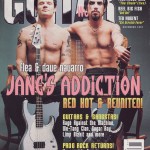
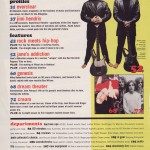
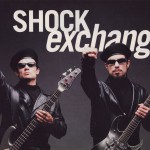
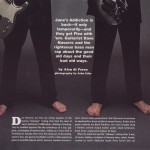



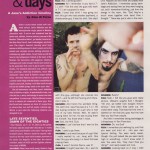
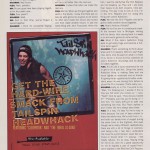
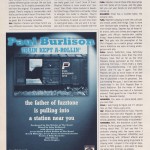
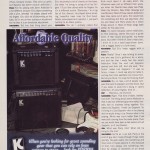

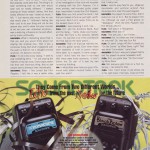
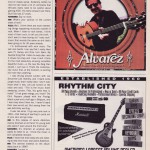
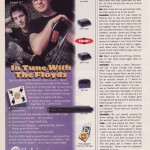
You must be logged in to post a comment.